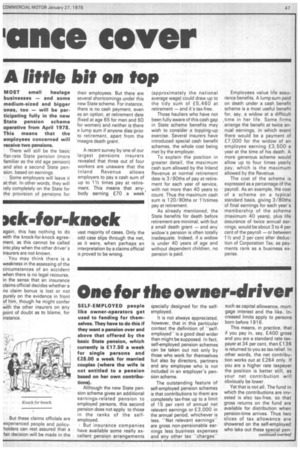Don't knock the Dck-for-knock
Page 48

Page 49

If you've noticed an error in this article please click here to report it so we can fix it.
PROBABLY "knock-forknock agreement" is the most misunderstood and most maligned term in vehicle insurance.
This is a pity because the knock-for-knock system saves a great deal of expense and legal argy-bargy — and repair work is not normally held up.
But what is the knock-forknock arrangement all about? Well, if two vehicles collide and both are comprehensively 'insured, each instiranOe company • involved pays for the damage to the vehicle it insures, irrespective of which driver is to blame. As regards loss or otherwise of any no claim bonus being earned, the decision rests with the insurers concerned, based on the circumstances of each case.
On the face of it, there is no doubt that this system seems unfair. The insurers of the blameworthy driver appear to be "getting away with it". But it is a case of the swings and roundabouts idea — or you could call it the law of averages — for all the insurers working the knockfor-knock system, and very few insurers are not a party to it.
Many drivers get the idea in their head that in some insidious way the knock-for-knock agreement is a major factor if there is a loss of no claim bonus. This not the case.
Insurers say that providE they could have obtained ft recovery of the amount thE have paid out from the otll driver's insurance comparr were there no knock-for-knot agreement in force, then thE insured driver's no claim bons would not normally be pr judiced.
Of course, if blame ci rightly be placed on both drive concerned in the accident, thi each one would almost certair be faced with loss of no clai bonus. Thus the prejudicing otherwise of a no claim bon' depends on the circur stances surrounding each ca which arises, and not on 0 operation of a knock-for-kno, agreement.
A vehicle damaged in a h and-run incident presents tF owner with an infuriating situ tion. He cannot be blamed if vehicle is bumped and damagi while it is standing or parked ir lorry park or car park. But if he unable to tell his insurers wt was responsible, they cann press a claim against the guil driver and will thus have to me the repair bill themselves.
As a result, the policyhold loses his no claim bonus. Om again, this has nothing to do with the knock-for-knock agreement, as this cannot be called into play when the other driver's insurers are not known.
You may think there is a weakness in the assessing of the circumstances of an accident when there is no legal recourse, in the sense that an insurance claims official decides whether a no claim bonus is lost or not purely on the evidence in front of him, though he might confer with the other insurers on any point of doubt as to blame, for instance. vast majority of cases. Only the odd case slips through the net, as it were, when perhaps an interpretation by a claims official is proved to be wrong.




















































































































